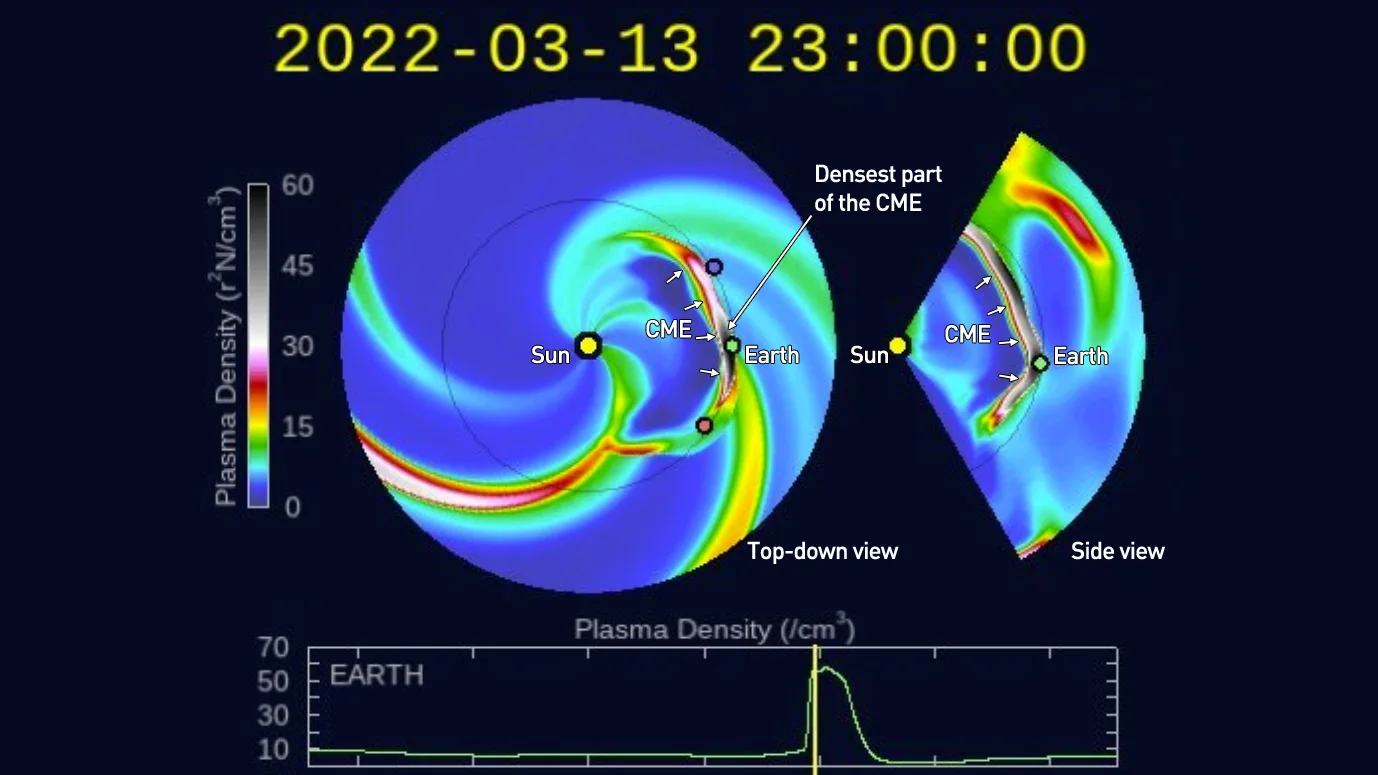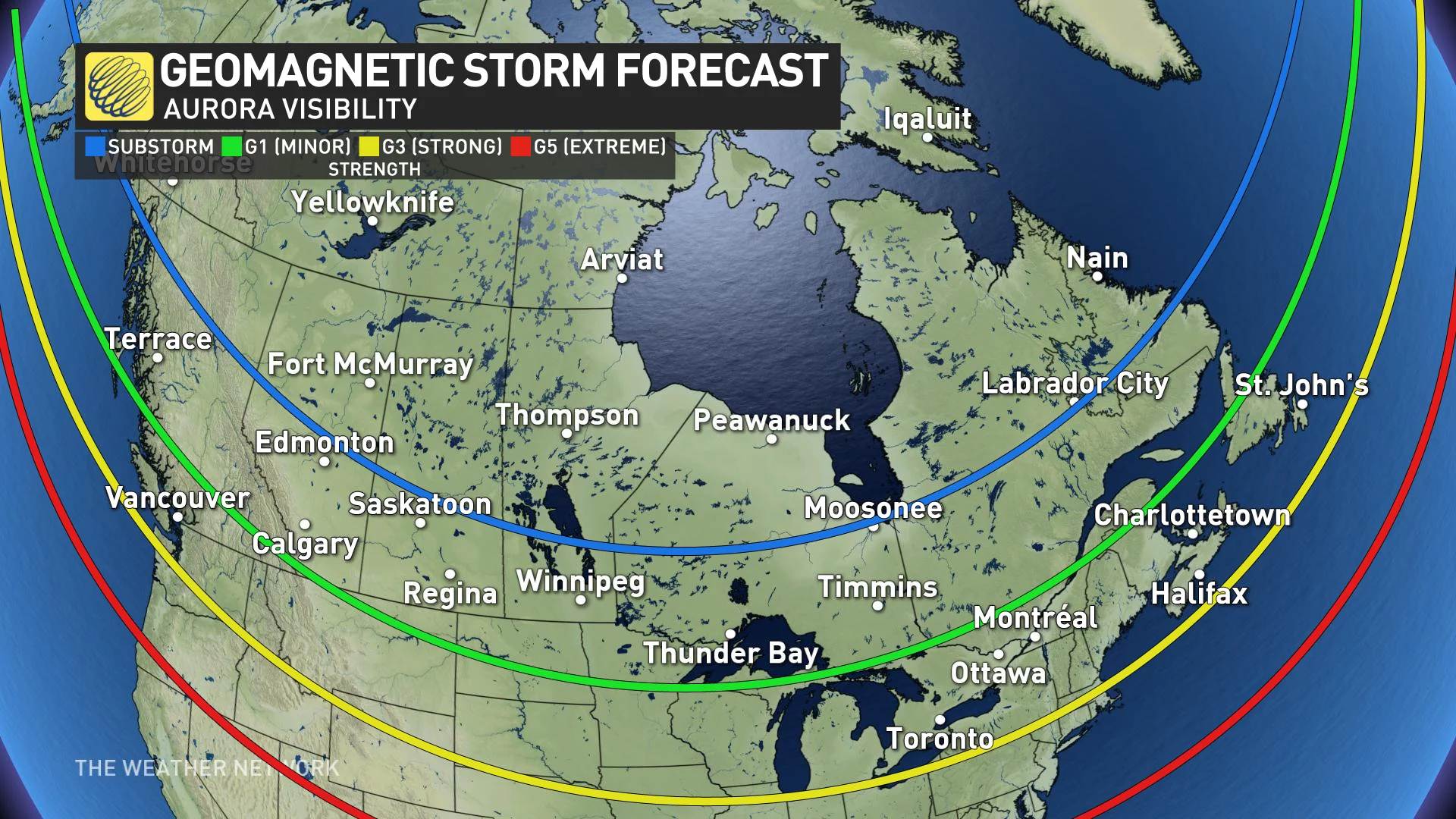
Eyes to the sky! Auroras may be visible across Canada Sunday night
Get ready, aurora watchers! We may see geomagnetic storms as early as Sunday night due to an immense coronal mass ejection erupting from the Sun.
An approaching solar storm appears to have Earth directly in its sights. When it sweeps past us, it may spark bright auroras visible all across Canada.
Originally posted on Friday, March 11, this story has been updated to reflect new information.
On the morning of Thursday, March 10, a relatively weak 'C-class' solar flare blasted out from the Earth-facing side of the Sun. While these flares are usually unremarkable, according to Dr. Tony Phillips of spaceweather.com, this particular one lasted for almost 12 hours.
As this long-duration flare was blasting out energy into space, it was accompanied by the eruption of a cloud of charged solar particles, known as solar plasma cloud, a solar storm, or a coronal mass ejection (CME).
The animation above, posted by Dr. Erika Palmerio, condenses hours worth of coronagraph observations by the NASA/ESA Solar and Heliospheric Observatory (SOHO) into seconds. While most of the cloud appears to expand towards the top and right of the animation, we can also see parts of it moving through the rest of the image, as well. Since it completely surrounds the Sun (which is in the middle of the image), this reveals it as a Full Halo CME, which means that it is aimed more or less directly at Earth.
NOAA's Space Weather Prediction Center tracks the progress of CMEs as they expand away from the Sun. Based on how these clouds appear in images captured by SOHO, forecasters run models that predict the shape of the cloud and whether it will affect us.
SWPC's Friday run of this model is shown in the tweet above. Watch the circle to the top left, which shows the density of solar particles in space throughout the inner solar system (blue being the least dense and black being the most dense). The Sun is the yellow dot at the centre. Earth is the green dot to the right of the Sun, with the red and blue dots flanking Earth being the twin STEREO satellites, which monitor solar activity. While the multi-coloured pinwheel pattern around the Sun shows the conditions of the solar wind, the multi-coloured arc cutting through the pinwheel from left to right is the March 10 CME.
According to the model, the CME will sweep past us late on Sunday, March 13.
Even a glancing blow by a CME is often enough to cause a geomagnetic storm. In this case, though, it appears as though Earth will be affected by the densest part of the cloud.

This condensed look at the WSA-ENLIL model run shows the CME encountering Earth at around 8 p.m. EDT, on Sunday, March 13. With the densest portion of the solar storm (coloured white and black) expected to sweep past Earth, the graph shows a spike in plasma density at that time. Credit: NOAA SWPC/Scott Sutherland
This encounter is expected to disturb the planet's magnetic field, causing a geomagnetic storm.
As of Saturday morning, NOAA SWPC has forecast a minor to moderate geomagnetic storm in the wake of the CME. As a result, on Sunday night, auroras could be visible across Canada and even into the northern parts of the United States.
WATCH FOR THE NORTHERN LIGHTS!
While it only takes around 8 minutes for the light from the SUn (and x-rays from a solar flare) to reach Earth, it takes CMEs a bit longer to cover the distance. Typically, they pass us a few days after the eruption. CMEs from exceptionally strong flares, however, have taken as little as 16 hours to reach us.
Watch Below: Chris St Clair talks to TWN science writer Scott Sutherland about the Sun, CMEs, geomagnetic storms and the Northern Lights
When a CME does pass by, the cloud of charged particles disturbs Earth's planetary magnetic field, causing what's called a geomagnetic storm. NOAA SWPC ranks geomagnetic storms on a 5-point scale: G1 (minor), G2 (moderate), G3 (strong), G4 (severe), and G5 (extreme). The severity is based on the predicted density, energy, and speed of the CME, and the impacts ramp up with each successive rank.
The strongest geomagnetic storms are capable of causing issues with power grids here on the ground, and with orbiting satellites as well. The probability of seeing these effects goes up with the severity of the storm. Most often, though, the most noticeable impact of any geomagnetic storm is the vibrant displays of aurorae we call the Northern and Southern Lights.
Auroras can be seen at pretty much any time of year in the far northern regions of Canada. However, during a geomagnetic storm the auroras tend to be brighter, and they are visible farther away from the poles. Thus, for the Northern Lights, the stronger the geomagnetic storm, the farther south into Canada and the United States the auroras can be seen.

On this map, the coloured arcs indicate how far south the Northern Lights can typically be seen, based on the geomagnetic conditions around Earth.
During a G2 (moderate) geomagnetic storm, the Aurora Borealis tends to be visible as far south as between the yellow and green arcs in the map above. Thus, it may be possible for skywatchers in southern Ontario to spot them on Sunday night, although they may not be bright enough to penetrate city light pollution. The auroras could be even brighter, though, depending on what happens.
As Dr. Tony Phillps notes on the spaceweather.com website, another CME already delivered a glancing blow to Earth's magnetic field on March 10.
"Ripples from the near miss sparked auroras in northern Europe bright enough to see through city lights," Phillips wrote.
If there are any residual impacts from that solar storm still lingering when the next one arrives Sunday night, it could ramp up geomagnetic activity over what is already expected.
Additionally, as the CME sweeps past us, its effects could be amplified by an 'equinox crack' — an opening in Earth's magnetic field that tend to form in March and September (around the equinoxes), which allow more of a CME's particles to slip through and interact with the upper atmosphere. If that does occur, it would likely mean we'll see even more intense auroras.
Watch for more updates throughout the weekend.
Read more: For more sights to see in the sky this season, and a guide for getting the most out of viewing astronomical events, see our Spring Night Sky Guide.
Thumbnail image provided by Alberta aurora chasers Tree and Dar Tanner.
